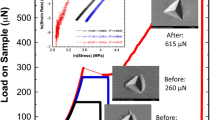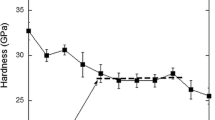Abstract
From studies of anisotropy in Knoop hardness1 and transmission electron microscopy of the deformation beneath indentations2, it is widely accepted that some dislocation movement is possible in diamond at room temperature. Three-point bend tests were used earlier to identify a brittle-to-ductile transition temperature of 1,500 °C (ref. 3), and extensive dislocation movement was considered unlikely at lower temperatures. Here we show, however, that multiple slip can occur in diamond as a result of the pressure transmitted by the point-loading of a softer material, namely a cubic boron nitride cone at 1,000 °C. The method enables specimens to be prepared for electron microscopy and X-ray topography that have a controlled density of dislocations introduced at homologous temperatures below 0.3 Tm, where Tm is the melting point. Furthermore, it underlines the importance of microplasticity in the application and performance of crystalline engineering ceramics.
Similar content being viewed by others
References
Brookes, C. A. Nature 228, 660–661 (1970).
Humble, P. & Hannink, R. H. Nature 273, 37–39 (1978).
Evans, T. & Wild, R. K. Phil. Mag. 12, 479–486 (1965).
Keh, A. S., Li, J. C. M. & Chou, Y. T. Acta Metall. 7, 694–699 (1959).
Brookes, C. A., O'Neil, J. B. & Redfern, B. A. W. Proc. R. Soc. A322, 73–88 (1971).
Roberts, S. G., Warren, P. D. & Hirsch, P. B. J. Mater. Sci. (in the press).
Kent, E. J., University Bristol (1976).
Hirsch, P. B., Pirousz, P., Roberts, S. G. & Warren, P. D. Science of Hard Materials (eds Almond, E. A., Brookes, C. A. & Warren, R.) 83–105 (Inst. Phys. Conf. Ser. No. 75, Hilger, Bristol, 1968).
Brookes, C. A., Hooper, R. M., Lambert, W. A. & Ross, J. D. J. Ultrahard Materials Applications Technology Vol. 2 (ed. Daniel, P. A.) 72–80 (De Beers International Diamond Div., 1983).
Frank, F. G., Lawn, B. R., Lang, A. R. & Wilks, E. M. Proc. R. Soc. A301, 239–252 (1967).
Brookes, C. A., Shaw, M. P. & Tanner, P. E. Proc. R. Soc., A409, 141–159 (1987).
Harrison, P. thesis, Univ. Exeter (1973).
Brookes, C. A. Properties of Diamond (ed. Field, J. E.) 383–402 (Academic, London, 1979).
Author information
Authors and Affiliations
Rights and permissions
About this article
Cite this article
Brookes, C., Howes, V. & Parry, A. Multiple slip in diamond due to a nominal contact pressure of 10 GPa at 1,000 °C. Nature 332, 139–141 (1988). https://doi.org/10.1038/332139a0
Received:
Accepted:
Issue Date:
DOI: https://doi.org/10.1038/332139a0
- Springer Nature Limited
This article is cited by
-
Dislocations produced in magnesium oxide crystals due to contact pressures developed by softer cones
Journal of Materials Science (1989)
-
Strategies to defeat brittleness
Nature (1988)





